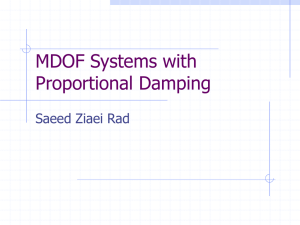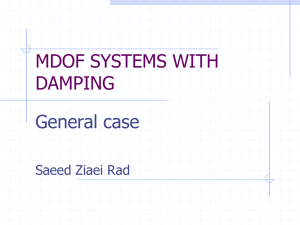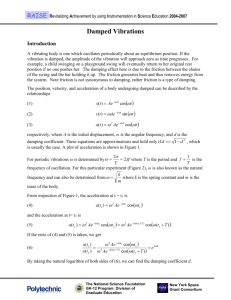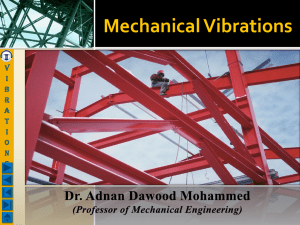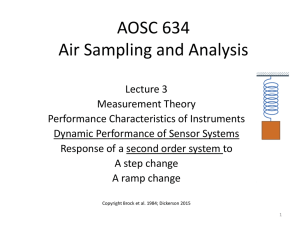A dynamical time-domain analysis for Heavy Weight
advertisement
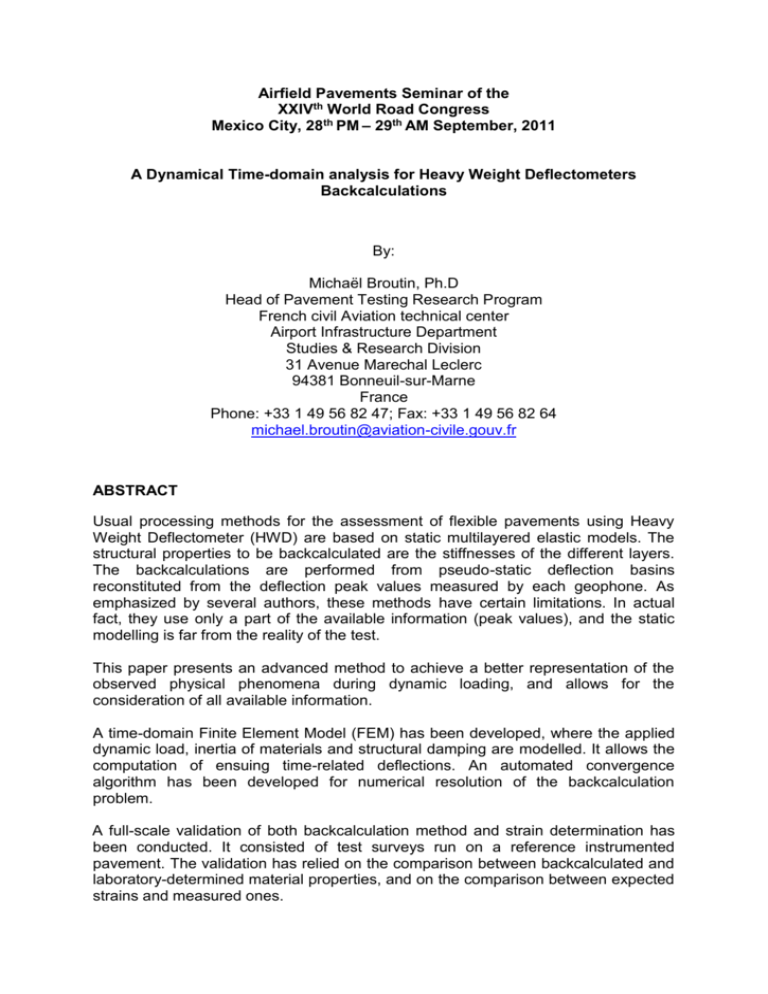
Airfield Pavements Seminar of the XXIVth World Road Congress Mexico City, 28th PM – 29th AM September, 2011 A Dynamical Time-domain analysis for Heavy Weight Deflectometers Backcalculations By: Michaël Broutin, Ph.D Head of Pavement Testing Research Program French civil Aviation technical center Airport Infrastructure Department Studies & Research Division 31 Avenue Marechal Leclerc 94381 Bonneuil-sur-Marne France Phone: +33 1 49 56 82 47; Fax: +33 1 49 56 82 64 michael.broutin@aviation-civile.gouv.fr ABSTRACT Usual processing methods for the assessment of flexible pavements using Heavy Weight Deflectometer (HWD) are based on static multilayered elastic models. The structural properties to be backcalculated are the stiffnesses of the different layers. The backcalculations are performed from pseudo-static deflection basins reconstituted from the deflection peak values measured by each geophone. As emphasized by several authors, these methods have certain limitations. In actual fact, they use only a part of the available information (peak values), and the static modelling is far from the reality of the test. This paper presents an advanced method to achieve a better representation of the observed physical phenomena during dynamic loading, and allows for the consideration of all available information. A time-domain Finite Element Model (FEM) has been developed, where the applied dynamic load, inertia of materials and structural damping are modelled. It allows the computation of ensuing time-related deflections. An automated convergence algorithm has been developed for numerical resolution of the backcalculation problem. A full-scale validation of both backcalculation method and strain determination has been conducted. It consisted of test surveys run on a reference instrumented pavement. The validation has relied on the comparison between backcalculated and laboratory-determined material properties, and on the comparison between expected strains and measured ones. INTRODUCTION Heavy Weight Deflectometer (HWD) is the international reference device used to assess the bearing capacity of airport pavements. Usual processing methods for the assessment of flexible pavements using this device are based on static multilayered elastic models. The structural properties to be backcalculated are the stiffnesses of the different layers. The backcalculations are performed from pseudo-static deflection basins reconstituted from the deflection peak values measured by each geophone. As emphasized by several authors, these methods have certain limitations. In actual fact, they use only a few part of available information (peak values), and the static modelling is far from the reality of the test. This is the reason why interest for dynamic methods has been growing for a few years ([1] or [2] for instance). The French Civil Aviation Technical Centre (STAC) has developed [3] a finite element dynamical model taking into account the whole force signal applied on the load plate. This makes it possible to model the impact of the falling weight on the structure and the resulting deformations. Dynamic backcalculations allow determination of the elastic modulus and possibly other parameters such as damping in the pavement materials. The dynamic modelling includes the entire temporal signal of each geophone. This paper describes the developed theoretical model and presents a full-scale experiment performed on the STAC’s flexible testing facility [4] in order to assess its correlation. Results of dynamical backcalculation are compared to pseudo-static backcalculation results (modulus of each material) and to experimental data obtained from laboratory tests performed on materials (modulus and damping factor). This paper includes three parts: - First, description of the experiment, - Second, presentation of the theoretical model and backcalculation procedure, - Finally, comparison with pseudo-static results and in-situ validation. 1 - PRESENTATION OF THE EXPERIMENTATION The experiment presented here is part of a study including repeatability and various parametric research that have been done upstream. Cross-reference tests between different apparatus have also been performed. The STAC’s test facility consists of a conventional airport structure (Surface Asphalt Concrete (named BC1 in the following)/ Base Asphalt Concrete (BC2)/ Humidified Untreated Graded Aggregate (UGA)/Natural Gravel (NG)/ Subgrade). Ground Penetrating Radar coupled with corings have been used to assess the layers thickness after the construction. Respective thicknesses of BC1, BC2, UGA and Natural Gravel on that point are 14,6; 17,8; 53,7 and 81,9 cm. A full geotechnical survey has been conducted at the experimental site. It has also included static cone penetrometer tests. The latter have allowed estimating that bedrock is 10 m deep. Ten points on the structure have been tested. Homogeneity of the test facility on these points has been demonstrated. One point, representative of the structures behaviour, is chosen here for the demonstration. Each test included 3 sequences corresponding to the respective strengths of 100, 150 and 200 kN applied on the pavement. Each sequence included 3 drops. Analysis of the different strengths has shown that pavement response is linear with the strength applied. The last drop relative to the 200 kN sequence is retained in the following calculations. Tests have been performed in the early morning, in order to limit the temperature variations during the experiment and to have a low gradient of temperature in the bituminous materials. The temperatures at different depths, measured using a portable data acquisition device, are summed up in Figure 1. These temperatures are almost constant during the whole measurement series. A minor gradient is observed, with the bottom of the layer being a little warmer due to inertia of the pavement, but mean temperature in the bituminous layer is constant, and in that way its mean stiffness too. The influence of mean temperature and gradient is not treated in this paper. T° [°C] 21 HWD tests ; Bonneuil Test Facility ; 29.09.2009 Bottom 20 19 18 17 Time Top 16 06:00 06:28 06:57 07:26 07:55 08:24 08:52 09:21 09:50 Figure 1 - Temperature evolution during the tests Temperatures retained are 18 °C in the BC2 layer and 17 °C in the BC1. Besides, impact time was very repeatable around the 30 ms mean value. That corresponds to a 33Hz mean solicitation frequency. 2-PROPOSED MODELLING AND BACKCALCULATION PROCEDURE 2.1 PROPOSED MODELLING The STAC has established a dynamic model for HWD data analysis. This model, implemented in the finite element software CESAR-LCPC (DYNI modulus) [5], is likely to better take into account the dynamic nature of the load and also the damping phenomenon occurring in pavement materials, not considered in the pseudo-static method. The model relies on a 2D axisymmetric mesh made up of quadratic elements. A typical mesh is presented in Figure 2 (in our case the mesh presents an additional layer: the natural gravel between the subgrade and the UGA). It includes the load plate. Structure of the test facility: p(t) Load plate G1 p(t) G3G4 G5 G6 G7 G8G9 Surface AC Base AC UGA L ur=0 ur=0 H Subgrade uz=0 (G1 is directly under the load plate. Respective radial distances of G2 to G9 to the plate center are 30, 40, 60, 90, 120, 150, 180 and 210 cm) Figure 2 - The mesh Layer thicknesses correspond to the real thicknesses of the studied pavement at each test point. For calculation time reasons the fineness of the mesh has been chosen in accordance with an optimization study led upstream. In the latter the optimization has been made numerically by successive refinements until stabilization of the theoretical deflections, given the expected precision. Final discretization led to a constant 3 cm step (x1) under the plate and a constant 50 cm step ( x2) far from it (d >3 m) with a geometric progression between these 2 areas to avoid introduction of any artificial stiffness in the system which could induce undesirable reflections. The width “L” of the mesh has been optimized to avoid reflections on the lateral boundary. The method was numerical, achieve by performing calculations for different L values meter by meter considering a timeframe of 60 ms. The study has established that L must be at least Lmin = 7 meters. The value L = 10 meters has been chosen in order to have a security margin to generalize this mesh geometry for all pavements. The height “H” of the mesh corresponds to the real bedrock depth. A sensitivity study done upstream showed that the presence of bedrock deeper than 6 meters has no influence on the results and the subgrade can be considered as infinite. Foinquinos Mera [6] already observed this phenomenon and retained the very close value of 20 ft. Therefore, as a conclusion H = 6 m is taken here. Boundary conditions are depicted in Figure 2: the radial displacement is null on the axis for symmetry considerations and on the external boundary, as well as the vertical one at the bottom of the mesh. As for the interface conditions, layers are assumed to be bonded. The external solicitation is the real stress applied on the load plate during the HWD test, which is recorded. Pressure under the plate is considered as uniform even if this hypothesis is debatable, especially for thin flexible structures. It has nevertheless been established (Boddapati and Nazarian, [7]) that only central deflection is affected by a possible pressure non-uniformity. The calculated pressure p(t) is applied on the plate. Time discretization has also been optimized. It is also based on a previous optimization study which has established that it is possible to keep only 1 time increment over 3 without any effect on results. All materials are considered to exhibit isotropic linear elastic behavior. Damping is introduced in the model. Only a global Rayleigh damping is available so far in the CESAR-LCPC software. This modeling amounts to introduce a damping matrix “C” in the local equations: M u C u K u P(t ) (1) with M and K are the respectively mass and stiffness matrices and C M K (2) with and constant for the whole structure. These parameters are called Rayleigh coefficients. They are linked for each i pulsation to the i damping ratio by the relation: 1 i i 2 i (3) As illustrated in Figure 3, the provisional method adopted to determine and consists in optimizing these two parameters to obtain an assigned value of % for mean damping ratio on the considered frequency range (0 to 80 Hz for HWD pulse times; in practice, inferior boundary is chosen non null to avoid infinite values ; 5 Hz is here arbitrarily chosen). It can be noted that damping is not uniform with frequency, damping being higher for low and high frequencies. Figure 3 highlights this frequency dependence. mean Figure 3 - Relation between Rayleigh coefficients and damping ratio . As a conclusion only parameters to be backcalculated from HWD data (applied load and resulting surface deflections) are the Young’s modulus of each material and the damping ratio in the structure. 2.2 THE BACKCALCULATION PROCEDURE RETAINED The problem consists in minimizing the ft function hereafter: m f t (E) qk k 1 w E t d t t max k 2 k (4) t t min where dk is the deflection measured at time t by the kth of the m geophones, wk is the corresponding theoretical deflection and qk are weighing coefficients, when E is a (n+1)-sized column vector containing elastic modulus (Ei) of each of the n layers of the structure and the damping ratio in the volume. Calculations have been performed using the PREDIWARE software developed by the STAC. This program allows creating automatically the mesh described in Figure 2 relative to the studied structure, and performing either pseudo-static or dynamic (with a constant or backcalculated damping ratio) backcalculations from in-situ HWD data, with calls to the Cesar-LCPC software for each direct calculation. Algorithm retained in the program is Gauss Newton. Its convergence and robustness have been demonstrated by performing backcalculations on simulated data set. At each iteration, 6 or 7 FEM calculations are performed: one for the initial situation and one by parameter (5 layers moduli and 1 damping factor). The principle is to calculate influence of a little variation of each parameter to build the sensitivity matrix to be inverted. Calculation is stopped if the targeted RMS error is reached or if the maximum imposed number of iterations is obtained. According to a previous sensitivity study the value of 100µm2 is set for the normalized RMS error (corresponding to RMS error divided by number of time steps considered) in the dynamic case and 5 µm2 in the pseudo-static case (RMS error divided by number geophones in this case). A maximum value of 20 iterations is chosen from experience. 3. COMPARISON VALIDATION WITH PSEUDO-STATIC RESULTS AND IN-SITU 3.1 COMPARISON WITH PSEUDO-STATIC RESULTS Figures 4 though 9 show fittings performed and associated convergence, in the case of a pseudo-static approach, a dynamic approach without damping, and a dynamic approach with damping, respectively. Weighting coefficients have been chosen all equal to 1. The influence of these coefficients is not studied in this paper. Final corresponding normalized RMS errors are 5m2 in the pseudo-static case, and 151 and 119 m2 in dynamic without and with damping respectively. Fitting is thus a little better when damping is introduced in the modeling. Common values for initial parameters have been arbitrarily chosen as robustness of the three convergences has been proved but is not presented here. Values of 4700, 9000, 200, 150 and 120 MPa for BC1, BC2, UGA, Natural Gravel and Subgrade have respectively been retained in the 3 cases. An initial 5 % damping ratio has been taken in the dynamic with damping case. Figure 4 - Identification in the pseudo-static case Figure 5 - Convergence in the pseudo-static case Figure 6 - Identification in the dynamic without damping case Figure 7 - Convergence in the dynamic without damping case Figure 8 - Identification in the dynamic case with damping Figure 9 - Convergence in the dynamic case with damping Results of the backcalculations are given in Table 1 as follows: Table 1 – Backcalculation results Backcalculation EBC1 [MPa] EBC2 [MPa] EUGA [MPa] ENG [MPa] ESubgrade [MPa] Static Dynamic without damping Dynamic with damping 2700 2500 2100 15500 9500 19500 510 700 280 540 560 325 76 66 45 [%] None None 38,5% Direct calculations performed using these backcalculated moduli allow determining the critical relative strains in the structure. In our case the latter are tensile strain at bottom of the BC2 layer and vertical ones at the top of every untreated layer. As the problem is linear, admissible strength to be applied 10 000 times on the pavement can be determined by proportionality, for each critical solicitation, knowing fatigue laws of materials. The most prejudicial strain allows defining the critical layer and to deduce a global admissible strength for the pavement. In our case fatigue laws are not yet available. By default limit strains for 10 000 applications is chosen to be equal to 300 m/m for BC2 and 1000 m/m for all untreated materials. Table 2 - Calculated strains XX ZZ ZZ Top UGA Top NG ZZ Critical Layer Backcalculation Bottom BC2 Static 8,9.10-5 3,18.10-4 1,16.10-4 1,43.10-4 UGA Dynamic without damping Dynamic with damping 9,4.10- 3,00.10-4 1,27.10-4 Top Subgrade 1,60.10-4 Adm. F [kN] 600 UGA 599 8,5.10-5 3,24.10-4 1,31.10-4 1,92.10-4 UGA 580 5 One can notice that critical strains are similar for the 3 modellings, and as a direct consequence the critical layer and admissible strength. 3.2 IN-SITU VALIDATION OF THE GLOBAL PROCEDURE Laboratory tests were performed on materials to validate backcalculated moduli and damping ratio if necessary. Concerning bituminous materials (BC1 and BC2) complex modulus E* = E1+iE2 have been determined for different combinations of temperatures and frequencies in the respective usual ranges where the HWD tests are performed. These tests were performed in the French Central Laboratory for Civil Works (LCPC). The E * E1 E2 norms of the complex moduli are compared to backcalculated 2 2 moduli whereas damping ratios are estimated thanks to the relation: 1 2 Q 1 E2 E1 Figures 10 and 11 show the evolution with temperature and frequency of the elastic modulus and damping ratio in the base asphalt concrete (BC2). Figure 10 - Evolution of elastic modulus of BC2 with frequency and temperature Figure 11 - Evolution of damping ratio in BC2 with frequency and temperature Elastic modulus and damping ratio of the BC2 at (18 °C, 33 Hz) can be determined using a linear interpolation between (15 °C, 30 Hz), (20 °C, 30 Hz), (15 °C, 40 Hz) and (20 °C, 40 Hz) values. Values found are |E*|BC2 = 17 000 MPa and BC2 = 12 %. On the other hand, the test laboratory values for elastic modulus and damping ratio of the BC1 are |E*|BC1 = 11 000 MPa and BC1 = 19 % for test conditions (17 °C, 33 Hz). With respect to untreated materials (the subgrade and the gravels), Resonant Column Tests [8] were performed in the LCPC. The main purpose is to estimate the damping ratios in these materials. These tests also give indication of the shear modulus of these materials, and in this way of elastic modulus. Elastic modulus E is linked to shear modulus G by the relation: G E 2 (1 ) (6) where is the Poisson’s ratio (taken equal to 0,35). This second information has to be taken cautiously for UGA and Natural Gravel materials as resonant column tests are normally kept for soil materials but have to be adapted for these materials by performing tests only on fines (the test apparatus does not allow the use of important dimension of gravels). Classical triaxial tests are in progress on these materials in order to have more precise elastic modulus values. The results relative to subgrade are presented on Figure 12 and Figure 13. These Figures are taken from LCPC’s « Essais à la colonne résonnante sur GRH et terrains naturels » report for STAC, dated as from 22 December 2009, written by P. Reiffsteck, S. Fanelli and J-L.Tacita. It appears that the shear modulus and the damping ratio increase with confining pressure. That is in line with expectations. The shear modulus decreases with distortion whereas damping ratio increases. The same behavior is found on gravels but is not presented here. These dependencies imply that distortion and confining pressure ranges must be known. Approximation of distortion and confining pressure p during a HWD test will iterate first on strains calculation in the pavement using backcalculated modulus and the hypothesis that , and iterate a second time on a calculation using a cone model, not presented here. Figure 12 - Evolution of shear modulus of subgrade with distortion and confining pressure Figure 13 - Evolution of damping ratio in subgrade with distortion and confining pressure The mean value of 1,65.10-4 is retained from the 3 backcalculations for strain at the bottom of the subgrade. Cone model predicts a 65 kPa value for confining pressure. These parameters allow calculating damping ratio and elastic modulus in the subgrade. Results are collected in Table 3. Table 3 - Determination of elastic modulus and damping ratio of the subgrade ZZ 1,65.10-4 3 G [MPa] 15 E [MPa] 40 The same approach is applied for UGA and Natural Gravel. All results are gathered in Table 4. Table 4 - Laboratory materials characterization E [MPa] [%] BC1 11000 19 BC2 17000 12 UGA (700) 3,5 Nat.Gravel (500) 3,5 Subgrade 40 3 These laboratory tests confirm first that damping is not uniform in the structure and that the feasibility to choose distinguished damping ratios in the different layers should be introduced. It requires some programming developments in the FEM program. This work is in progress. The use of Rayleigh damping itself is also questionable. Expected values for global damping ratio was a mean value between low values in untreated materials (3 %) and high values in the bituminous ones (12-19 %). The mean value of 38 % is thus unrealistic. Damping ratio frequency dependence of BC2 is given in Figure 11. BC1 presents the same general trend. A method to come closer to the general behavior shown in Figure 3 is choosing = 0 but there is no proof that untreated materials behavior is similar. Advanced research has to be performed to ascertain if sophisticated damping modelling where damping ratio frequency dependence could be controlled is necessary or if Rayleigh damping by layers could be sufficient. The laboratory tests also show that backcalculated moduli are coherent, except for the BC1 layer (even if value backcalculated for the 3 backcalculations are similar). It can be assumed that the test is not appropriate to characterize the thin upper layer. This can be due to the great radius of the load plate in comparison with the layer thickness or to the fact that hypothesis of a constant pressure under the plate may not be correct. As for the subgrade modulus, dynamic modelling with damping is much better than the peudo-static one. UGA and Natural Gravel modulus seem to be better approximated in the pseudo-static case, but as explained above Resonant Column Tests are not well adapted to these materials. Triaxial tests are in progress. Finally results for BC2 layer are equivalent in both pseudo-static and dynamic with damping cases. In conclusion, and while waiting for the triaxial tests results, dynamic backcalculation with damping seems to be more realistic than the pseudo-static, and this may be further demonstrated as the damping model improves. CONCLUSIONS AND FUTURE WORKS A dynamical rational FEM model for HWD data analysis has been presented in this paper. This model provides promising results. Although damping modelling is not satisfactory, it consists of a global structural Rayleigh damping, and laboratory tests on materials emphasized important disparities in materials damping ratios. Modelling is to be improved by introducing a Rayleigh damping by layers, or more preferred a damping by layers with a sophisticated model for each layer where damping ratio frequency dependence would be controlled. This work is in progress. Laboratory tests on materials confirm ranges of the backcalculated modulus for the 3 modellings, except for upper bituminous layer. Dynamical backcalculation seems nevertheless to be more realistic. Critical strains and in that way residual life found for the pavement for pseudo-static and dynamic methods are similar on this case study. One can wonder if it is due to experimental pavement configuration, or if it will be the case for other pavements (with thinner bituminous layer, or with a not very deep bedrock for instance). Dynamic modeling for this purpose will be tested on other structures in the near future. Another important project to be conducted will consist of validating the model by comparing calculated critical strains with in-situ measurements on gages embedded in the test facility. A wide-scale experiment is in progress, using the STAC’s instrumented test facility [4]. REFERENCES 1. Al Khoury, Scarpas, Kastergen, Blaauwendraad (2002), “Dynamic Interpretation of Falling Weight Deflectometer Test Results. Spectral Element Method”, Transportation Research Record 1716, pp.49-54 2. Chatti, Ji, Harichandran (2004), “Dynamic Time Domain Backcalculation of Layer Moduli, Damping and Thicknesses in Flexible Pavements”, Transportation Research Record 1869, pp.106-116 3. Broutin, (2010) “Assessment of flexible airfield pavements using Heavy Weight Deflectometers; Development of a FEM dynamical time-domain analysis for the backcalculation of structural properties”, PhD thesis 4. Broutin,Caron,Deffieux (2009), “Dynamic versus static testing of airfield pavements: a full-scale experiment in France”, European Road Review n°13, pp. 17-25 5. “Numéro spécial CESAR-LCPC” (2005), Bulletin des Laboratoires des Ponts et Chaussées, N° 256-257 6. Foinquinos Mera (1995), “Dynamic Nondestructive Testing of Pavements” , Geotechnical Engineering Report GR95-4, Geotechnical Engineering Center, University of Texas at Austin, Austin, Texas 7. Boddapati and Nazarian (1994), “Effects of Pavement-Falling Weight Deflectometer Interaction on Measured Pavement Response”, Nondestructive Testing of Pavements and Backcalculation of Modulus, Second Volume, ASTM SPT 1198, Harold L. Von Quintus, Albert J.Bush, III, and Gilbert Y. Baladi, Eds., American Society for Testing and Materials, Philadelphie, pp. 326-340. 8. ASTM, “Standard Test Methods for Modulus and Damping of Soils by Resonant-Column” ASTM standard

